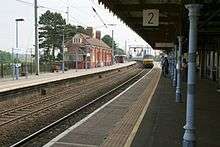Manningtree railway station
Manningtree railway station is on the Great Eastern Main Line (GEML) in the East of England, serving the town of Manningtree, Essex. It is 59 miles 35 chains (95.66 km) down the line from London Liverpool Street and is situated between Colchester to the west and Ipswich to the east.[1] The three-letter station code is MNG. It is also the western terminus of the Mayflower Line, a branch line to Harwich Town. The following station on the branch is Mistley.
| Manningtree | |
|---|---|
| Location | |
| Place | Lawford |
| Local authority | Tendring |
| Grid reference | TM093322 |
| Operations | |
| Station code | MNG |
| Managed by | Greater Anglia |
| Number of platforms | 3 |
| DfT category | C2 |
| Live arrivals/departures, station information and onward connections from National Rail Enquiries | |
| Annual rail passenger usage* | |
| 2014/15 | |
| 2015/16 | |
| 2016/17 | |
| 2017/18 | |
| 2018/19 | |
| History | |
| Key dates | Opened 1846 |
| National Rail – UK railway stations | |
| |
The station is currently operated by Greater Anglia, who also operate all trains serving it, as part of the East Anglia franchise.
History
The station was opened by the Eastern Union Railway in 1846[2] but rebuilt by the Great Eastern Railway in 1899–1901; this building survives. It was designed by W. N. Ashbee.
Description

Immediately east of the station there is a triangle of junctions, known as the Manningtree South, North and East junctions and originally each double-track junction was controlled by an individual signal box. In 1926 the London and North Eastern Railway installed a new power box at Manningtree South which controlled all three junctions.[3] Today, the north to east curve connecting Ipswich with Harwich Town is a single track, having been reduced from double-track.[4] All three sides of the triangle are electrified.
A second peculiar feature just east of the station is a combination of a road underpass and a level crossing. The underpass has limited height and the parallel level crossing is needed to permit higher vehicles to cross the railway.
Platform 1 (bay platform) has an operational length for five-coach trains, platform 2 (London-bound) and platform 3 (country-bound) each have an operational length for twelve-coach trains.[5] There is a fourth platform on the outer side of the "down" (country-bound) platform which is electrified, but its use would be confined to emergency situations. It can only be used to access the Ipswich main line, whereas the end bay at the country end of the "up" (London-bound) platform can only be accessed from the Mayflower Line.[6]
The station has (on the country-bound platform) a manned booking office and a self-service ticket machine. There is a side-gate west of the station building for use outside of office hours and a self-service ticket machine is also available here. There is a station buffet at the eastern end of the building.
The installation of lifts started in December 2015 and they are due to be in operation in Autumn 2016.[7][8]
Accidents
- On 20 August 1898, five people were slightly injured in a collision between a train and two carriages it was moving to attach to at Manningtree. The stationary carriages contained around 50 passengers and had just been detached from a main line train; they were due to be attached to the branch line train for Harwich Town but it reversed back to them at too great a speed and shunted into them with sufficient force to propel them backward by five or six yards. A Board of Trade investigation reported the driver misjudged the position of the carriages and the speed of his train, and the shunter failed to timely signal to the driver that he was too close to the coaches and moving too fast.[9]
Services
The following services typically call at Manningtree:[10]
| Operator | Route | Rolling stock | Frequency |
|---|---|---|---|
| Greater Anglia | London Liverpool Street - Colchester - Manningtree - Ipswich - Diss - Norwich | Class 745 , Class 321 | 1x per hour |
| Greater Anglia | London Liverpool Street - Stratford - Chelmsford - Colchester - Manningtree - Ipswich - Stowmarket - Diss - Norwich | Class 745 , Class 321 | 1x per hour |
| Greater Anglia | London Liverpool Street - Stratford - Shenfield - Chelmsford - Hatfield Peverel - Witham - Kelvedon - Marks Tey - Colchester - Manningtree - Ipswich | Class 321, Class 360 | 1x per hour |
| Greater Anglia | Manningtree - Mistley - Wrabness - Harwich International - Dovercourt - Harwich Town | Class 321, Class 360 | 1x per hour |
References
- Yonge, John (September 2006) [1994]. Jacobs, Gerald (ed.). Railway Track Diagrams 2: Eastern (3rd ed.). Bradford on Avon: Trackmaps. map 5C. ISBN 0-9549866-2-8.CS1 maint: ref=harv (link)
- Moffat, Hugh (1987). East Anglia's First Railways. Lavenham: Terence Dalton. ISBN 0-86138-038-X.
- Bonavia, Michael R. (1985) [1982]. A History of the LNER, Vol. 1, The First Years 1923-33. London: Guild Publishing. p. 60. CN 4143.CS1 maint: ref=harv (link)
- Mitchell, Vic (June 2011). Branch lines to Harwich and Hadleigh. Midhurst: Middleton Press. plates 3 and 4. ISBN 978-1-908174-02-4.CS1 maint: ref=harv (link)
- Brailsford, Martyn (2016). Railway Track Diagrams Volume 2 Eastern. Frome: Trackmaps. p. 6. ISBN 978-0-9549866-8-1.
- Mitchell 2011, plate 10
- End of Year 2015
- Manningtree station update
- http://www.railwaysarchive.co.uk/documents/BoT_Manningtree1898.pdf
- Table 11 National Rail timetable, May 2016
External links
| Wikimedia Commons has media related to Manningtree railway station. |
| Preceding station | Following station | |||
|---|---|---|---|---|
| Greater Anglia | ||||
| Terminus | Greater Anglia Mayflower Line | |||
| Historical railways | ||||
| Great Eastern Railway | Bentley |
|||